|
Home
John Torkelson
Group Members
Research
Publications
Patents
Alumni
|
Gradient Copolymers
Gradient copolymers are a novel class of polymers that exhibit a gradual change in composition along the chain from mostly A-monomer to mostly B-monomer. This arrangement is very different from traditional random copolymers, which maintain a constant average composition along the chain, and block copolymers, which change abruptly once from purely A-monomer to purely B-monomer.
|
|
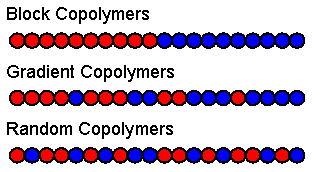
|
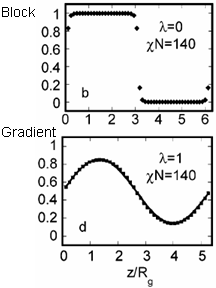
|
|
The gradual change in composition of gradient copolymers results in a reduced interchain repulsion compared to block copolymers. Theoretical studies have predicted that the degree of composition variation in gradient copolymers can be altered through the monomer distribution and that they will organize into sinusoidal composition profiles, rather than the step-like profiles seen for block copolymers (Lefebvre et al., Macromolecules, 2004 [Link]). This results in a wide range of possible local environments, rather than the one or two seen in random and block copolymers. (Figure adapted from Lefebvre et al.)
|
Controlled free radical polymerization techniques allow for the controlled addition of monomers to a growing radical chain, with the instantaneous chain composition being a function of the instantaneous comonomer composition of the reaction mixture. Thus, a gradient copolymer can be created through the gradual addition of a second monomer to a reaction vessel containing the first monomer. We use nitroxide-mediated CRP for our gradient copolymers.
|
|
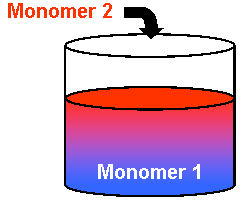
|
Compatibilization of Immiscible Polymer Blends via Hydrogen Bonding Effects
J. Kim, H.Y. Zhou, S.T. Nguyen, and J.M. Torkelson, Polymer 47, 5799-5809 (2006).
[Link]
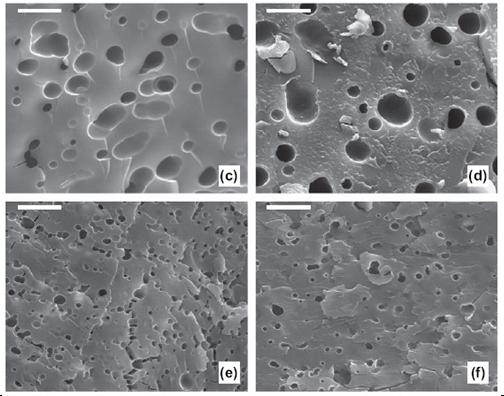 In this work, we investigated the application gradient copolymer for coarsening suppression in blends in which hydrogen bonding exists between the dispersed phase and one of the repeat units of the added gradient copolymer. The gradient copolymer system used was styrene / 4-hydroxystyrene (S/HS) in an immiscible polystyrene / polycaprolactone blend. A random S/HS copolymer system was also used for comparison. The S/HS random copolymer failed as a compatibilizer (Fig. c [before anneal] and d [after anneal]) while both gradient copolymers were good compatibilizers. Relative to the blend without copolymer, the blend with 59/41 mol% S/HS gradient copolymer exhibited a major reduction in initial dispersed-phase domain size and resulted in irregularly shaped domains (Fig. e [before anneal] and f [after anneal]), which are indicators of a sharply reduced interfacial tension. The presence of S/HS copolymers in the blend led to reduced PCL crystallization and melting temperatures as well as reduced enthalpies of crystallization and melting, consistent with some solubilization of copolymer in the PCL domain interiors.
In this work, we investigated the application gradient copolymer for coarsening suppression in blends in which hydrogen bonding exists between the dispersed phase and one of the repeat units of the added gradient copolymer. The gradient copolymer system used was styrene / 4-hydroxystyrene (S/HS) in an immiscible polystyrene / polycaprolactone blend. A random S/HS copolymer system was also used for comparison. The S/HS random copolymer failed as a compatibilizer (Fig. c [before anneal] and d [after anneal]) while both gradient copolymers were good compatibilizers. Relative to the blend without copolymer, the blend with 59/41 mol% S/HS gradient copolymer exhibited a major reduction in initial dispersed-phase domain size and resulted in irregularly shaped domains (Fig. e [before anneal] and f [after anneal]), which are indicators of a sharply reduced interfacial tension. The presence of S/HS copolymers in the blend led to reduced PCL crystallization and melting temperatures as well as reduced enthalpies of crystallization and melting, consistent with some solubilization of copolymer in the PCL domain interiors.
|
Uniquely Broad Glass Transition Temperatures of Gradient Copolymers
J. Kim, M.M. Mok, R.W. Sandoval, D.J. Woo, and J.M. Torkelson, Macromolecules 39, 6152-6160 (2006).
[Link]
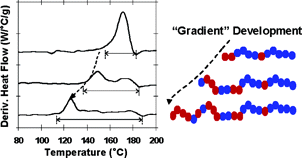 Differential scanning calorimetry (DSC) was used to study the glass transition breadths of styrene / 4-acetoxystyrene (S/AS) and styrene / 4-hydroxystyrene (S/HS) random, block and gradient copolymers. A single, narrow Tg was obtained in each random copolymer, consistent with a single phase of limited compositional nanoheterogenity. Two narrow Tgs were evident in each block copolymer, consistent with well-developed nanophases containing nearly pure S or nearly pure AS or HS units with a very narrow interphase yielding no indication of an intermediate Tg. In contrast, Tg breadths of ~ 65 - 80 degree C were observed in many S/HS gradient copolymers, consistent with ordered nanostructures in which the unit cell composition varies sinusoidally. In the figure, the derivative heat flow curves of aliquots taken during a polymerization clearly show the glass transition region broadening as the reaction proceeds.
Differential scanning calorimetry (DSC) was used to study the glass transition breadths of styrene / 4-acetoxystyrene (S/AS) and styrene / 4-hydroxystyrene (S/HS) random, block and gradient copolymers. A single, narrow Tg was obtained in each random copolymer, consistent with a single phase of limited compositional nanoheterogenity. Two narrow Tgs were evident in each block copolymer, consistent with well-developed nanophases containing nearly pure S or nearly pure AS or HS units with a very narrow interphase yielding no indication of an intermediate Tg. In contrast, Tg breadths of ~ 65 - 80 degree C were observed in many S/HS gradient copolymers, consistent with ordered nanostructures in which the unit cell composition varies sinusoidally. In the figure, the derivative heat flow curves of aliquots taken during a polymerization clearly show the glass transition region broadening as the reaction proceeds.
|
Gradient Copolymer Micellization in Homopolymer
C.L.H. Wong, J. Kim, C.B. Roth, and J.M. Torkelson, Macromolecules 40, 5631 - 5633 (2007).
[Link]
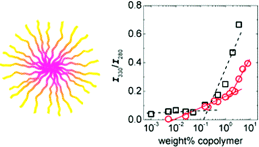 Our group has used the intrinsic fluorescence of styrene to compare the cmc's of gradient copolymer and block copolymer in blends with homopolymer. We investigated styrene (S)-methyl methacrylate (MMA) copolymers present at low levels in poly(methyl methacrylate) (PMMA). Intrinsic styrene fluorescence has been rarely used for cmc determinations of block copolymer in solvent and never for block or gradient copolymer in homopolymer. In our studies, we show not only that the determination of cmc's by intrinsic fluorescence is particularly simple for S-containing copolymers in a nonfluorescent homopolymer but also that the cmc of a gradient copolymer (red circles) is substantially larger than that of a related block copolymer (black squares), in agreement with theory.
Our group has used the intrinsic fluorescence of styrene to compare the cmc's of gradient copolymer and block copolymer in blends with homopolymer. We investigated styrene (S)-methyl methacrylate (MMA) copolymers present at low levels in poly(methyl methacrylate) (PMMA). Intrinsic styrene fluorescence has been rarely used for cmc determinations of block copolymer in solvent and never for block or gradient copolymer in homopolymer. In our studies, we show not only that the determination of cmc's by intrinsic fluorescence is particularly simple for S-containing copolymers in a nonfluorescent homopolymer but also that the cmc of a gradient copolymer (red circles) is substantially larger than that of a related block copolymer (black squares), in agreement with theory.
|
|
|